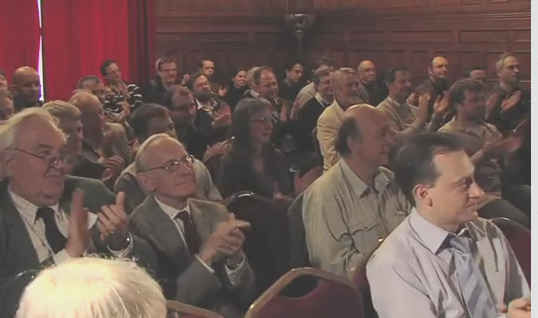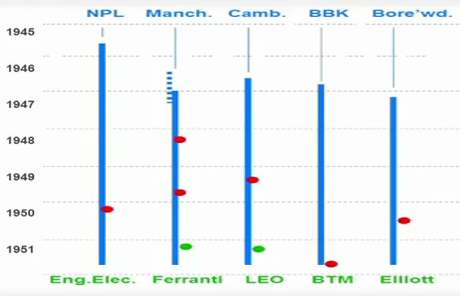| Turing and His Times |
| Written by Historian | |||
| Monday, 28 May 2012 | |||
|
An event held last month at Bletchley Park as part of the Alan Turing Centenary celebrations, centered largely on the ACE, the computer Turing designed. The UK National Museum of Computing has posted three videos of an event held last month at Bletchley Park as part of the Alan Turing Centenary celebrations, centered largely on the ACE, the computer Turing designed. The first of the three is essentially a video within a video that begins around at around three and a half minutes. Commissioned by the National Physical Laboratory (NPL), "Piloting Computing: Alan Turing's Automatic Computing Engine" presents the recollections of two of Turing's colleagues there that give a more personal insight into the ACE project than is recorded elsewhere.
Mike Woodger, who was appointed as Turing's assistant starts by explaining: "Nobody knew it was going to be an electronic computer [as opposed to the relay computers that were then the norm] until in 1946 a complete description by AT was put before the executive committee of the NPL who approved it a month later." Tom Vickers then gives some insights of the way in which Turing developed a reputation for "being a bit difficult". Mike Woodger, however, remembers his more considerate side. Although after two years at NPL Turing moved on, leaving the project in the lurch until NPL's electronics section stepped into help Woodger says: "There wouldn't have been a Pilot ACE without Turning. He produced, astonishingly, a complete description of the machine - sufficiently complete to know what to do next." He also tells us that it was Immediately put to use: "It wasn't supposed to be used for calculation but that's what happened." As Vickers explains, the Pilot ACE was supposed to be abandoned in order to move on to its full scale successor, but Jim Wilkinson made, a successful case to continue with it. Finished in 1950 it became available for hire, and was used by both government and industry. The video recounts how it was used to perform calculations to solve the mystery of an mid-air explosion of a Comet airliner that had grounded BOAC's fleet of Comets.
In the second video Simon Lavington, whose book Alan Turing and his Contemporaries was recently published, looks at how the design of stored program computers in the UK was influenced by ENIAC and the EDVAC report and how there was considered to be a "strategic need" for the UK to have one (i.e. only one) of these computers for the scientific/defense calculations. His talk explains how five groups in the UK, each small in size, tried to build one. They were located at NPL, the Universities of Cambridge and Manchester, Birbeck College in London and Borehamwood in Hertfordshire.
Timeline of five UK computer projects and their commercial successors Lavington's talk looks at Turing's life at NPL; at Cambridge, where Maurice Wilkes, responsible for building EDSAC and Turing could hardly bear to talk to each other by 1948; and at Manchester where the Mark I computer had been built by Freddie Williams and Tom Kilburn.
Turing's role at Manchester was to advise on I/O equipment and programming systems. Turing and Max Newman were also users of the Mark I, using it for investigating the Reimann-Zeta function and Mersenne Primes. In 1949 while at Manchester, Turing instigated a Symposium on The Mind and the Computing Machine for which he wrote his paper containing the Turing Test. By Oct 1951, after writing the first programming manual, Turing handed over responsibility for software development in order to devote himself to his work on morphogenesis, which he continued until his untimely, death in 1954 which came as a unexpected shock to his colleagues at Manchester.
In the final video, Kevin Murrell Explains how the Pilot ACE was different from other computers at the time and how programming it differed, using punch cards to get data and programs into the machine and punched punch cards for output. The complexity of the Pilot ACE made using it a very different experience from using a computer today and the museum is building a software version of the Pilot ACE control so that visitors can discover for themselves just what it meant to run a program on it.
The lecture was the second in a series linking up top three computing museums. At the first, which took place at The Computer History Museum in California on March 7, historian George Dyson spoke about the influence of Alan Turing on John von Neumann and vice versa in a talk entitled "Turing's Cathedral". The third took place 26 May at the Heinz Nixdorf Museum in Paderborn. Videos of its two short lectures: Professor Dr Horst Zuse talking about his father Konrad Zuse and his computers and Professor Dr Paul Rojas comparing Turing and Zuse, plus videos of its Turing exhibition and the Heinz Nixdorf Museum's working mechanical Turing machine are expected to come online in due course.
More InformationTuring and his Times - National Musuem of Computing Related ArticlesAlan Turing and his contemporaries (Review of Simon Lavington's book) Turing Centennial Celebration at Princeton
To be informed about new articles on I Programmer, sign up for our weekly newsletter, subscribe to the RSS feed and follow us on Twitter, Facebook or Linkedin.
Comments
or email your comment to: comments@i-programmer.info
|
|||
| Last Updated ( Monday, 29 January 2024 ) |





